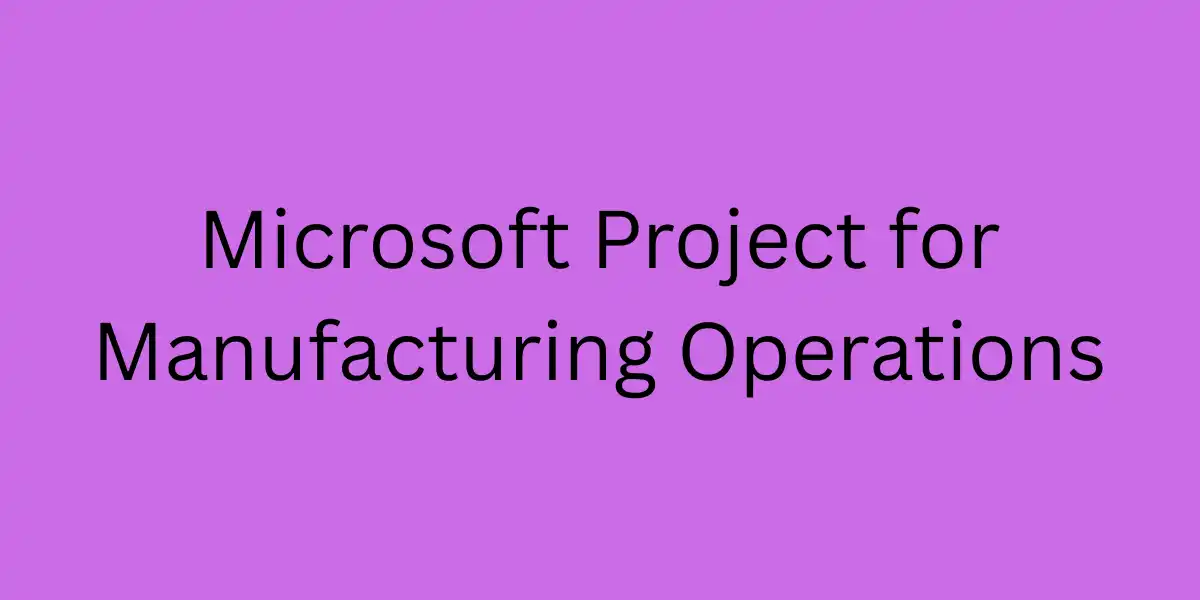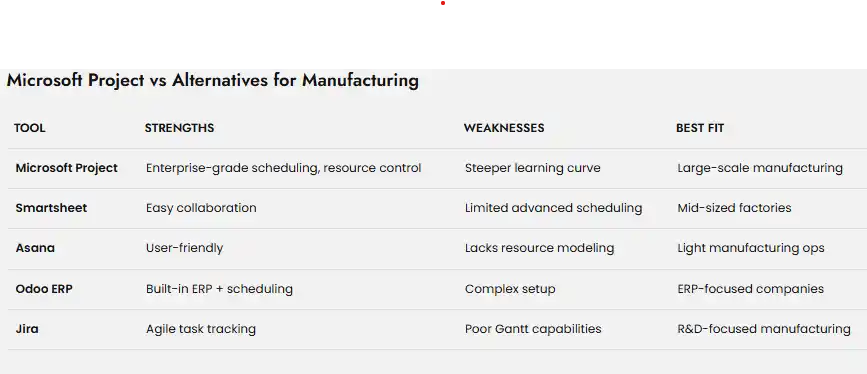Microsoft Project for Manufacturing Operations

Introduction: Why Manufacturing Needs Smarter Project Management
In today’s manufacturing landscape, efficiency isn’t just a competitive advantage—it’s survival. Lean supply chains, rising energy costs, and customer demand for faster delivery all push manufacturers to optimize production schedules and ensure every resource is used effectively.
Yet, without the right tools, production planning often turns into a nightmare:
Machines sit idle because of poor sequencing.
Materials arrive late due to supplier delays.
Workforce schedules clash with production deadlines.
Costs escalate when rework and downtime creep in.
Enter Microsoft Project—a powerhouse tool that transforms complex manufacturing operations into streamlined, well-coordinated systems. Paired with production schedule optimization, it enables manufacturers to not only keep up with demand but also to deliver higher quality, faster, and at lower costs.
The Role of Microsoft Project in Manufacturing Operations
Microsoft Project isn’t just for IT or office projects—it’s perfectly suited for manufacturing operations, where precision, timing, and resource allocation are mission-critical.
Here’s how it fits seamlessly into manufacturing:
Detailed Scheduling: Plan production runs by machines, shifts, and workforce availability.
Resource Management: Allocate raw materials, machine time, and labor effectively.
Dependency Tracking: Ensure that one process (e.g., assembly) doesn’t start before another (e.g., machining) is complete.
Cost Control: Monitor costs of labor, equipment use, and downtime.
Compliance & Standards: Track milestones aligned with ISO, OSHA, or industry certifications.
Features of Microsoft Project for Manufacturing
1. Gantt Chart Scheduling
Create visual timelines for every production step.
Easily adjust schedules when unexpected delays occur.
2. Resource Allocation
Assign machinery, operators, and raw materials to specific tasks.
Avoid double-booking or underutilization.
3. Scenario Planning
Run “what-if” simulations to test different production strategies.
Minimize risk during seasonal demand spikes.
4. Supply Chain Integration
Track supplier deliveries.
Link dependencies to production lines.
5. Cost Tracking
Monitor energy, material, and workforce costs in real time.
Flag overruns early to reduce waste.
6. Collaboration with Teams
Integrates with Microsoft Teams for factory-floor communication.
Syncs with Power BI for executive dashboards.
Benefits of Microsoft Project for Manufacturing Operations
1. Improved Production Efficiency
By optimizing production schedules, plants can increase throughput by 15–30%.
2. Reduced Downtime
Accurate dependency mapping ensures machines aren’t left idle.
3. Lower Operating Costs
Energy-intensive operations are scheduled during low-rate hours.
4. Better Workforce Management
Shifts are balanced to avoid overtime costs and burnout.
5. Enhanced Customer Satisfaction
On-time delivery improves customer trust and repeat orders.
How Microsoft Project Enables Production Schedule Optimization
Step 1: Define the Production Workflow
Break down production into phases: machining, assembly, finishing, packaging.
Step 2: Identify Dependencies
Example: painting can’t start until assembly is complete.
Step 3: Allocate Resources
Assign machinery and workforce based on availability.
Step 4: Optimize with Templates
Leverage production schedule templates in Microsoft Project to save time.
Step 5: Monitor and Adjust
Use dashboards to track performance and adjust when bottlenecks occur.
Use Cases in Manufacturing Operations
1. Automotive Production Lines
Track thousands of parts, suppliers, and assembly stages.
Reduce downtime by aligning robotic workflows with human operators.
2. Food & Beverage Manufacturing
Plan batch runs for perishable goods.
Manage supplier schedules for raw ingredients.
3. Electronics Manufacturing
Schedule SMT (surface-mount technology) machines.
Align testing and quality assurance phases.
4. Pharmaceuticals
Comply with FDA production guidelines.
Track validation and documentation milestones.
5. Heavy Equipment Manufacturing
Manage long lead times for parts.
Optimize workforce scheduling for multi-shift production.

Frequently Asked Questions (FAQs)
Yes—Microsoft Project supports Scrum, Kanban, and hybrid Agile-Waterfall workflows.
It synchronizes sprints, backlogs, and work items with Project schedules.
Yes—it allows compliance checkpoints, document linking, and audit-ready reporting.
Alignment of IT projects with business goals while reducing risks and delays.
Because it combines enterprise scheduling, compliance tracking, and integration with Microsoft’s IT ecosystem, making it ideal for high-stakes IT upgrades.
By embedding compliance milestones, tracking risks, and providing predictive insights.
Microsoft Project combines enterprise resource planning, reporting, and Agile boards, whereas Jira is focused mainly on software development.
Yes. Through Power BI dashboards and reporting, executives can track IT project performance in real time.
Yes. By visualizing dependencies, teams reduce risks of unexpected service outages.
Conclusion: Microsoft Project is the IT Department’s Secret Weapon
For IT departments balancing innovation, compliance, and execution, Microsoft Project is more than just a scheduler—it’s a strategic backbone.
It simplifies software development project planning.
Enables collaboration across IT and business units.
Supports compliance and documentation tracking.
Provides executive-level dashboards for real-time decision-making.
When integrated with the broader Microsoft ecosystem, Project becomes the central hub of IT project excellence.
Microsoft Project empowers IT leaders by:
Supporting Agile sprints, Kanban, and hybrid workflows.
Offering deep integration with Microsoft Teams, Azure DevOps, and Power BI.
Combining flexibility with compliance and governance.
Providing enterprise reporting dashboards for CIOs and CTOs.
For IT departments, this means faster project delivery, lower risks, and higher business value.
